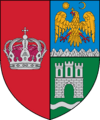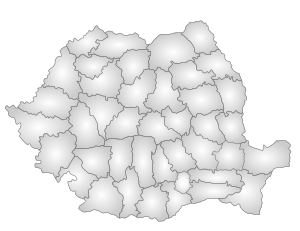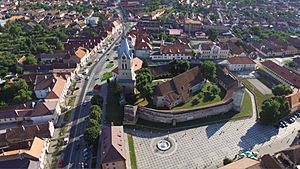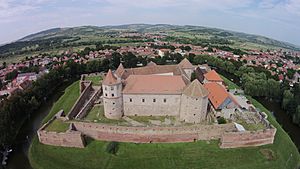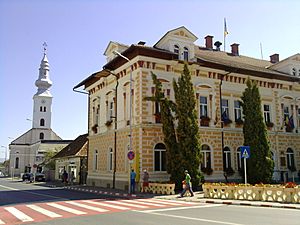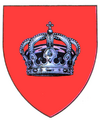Brașov County facts for kids
Brașov County (called Județul Brașov in Romanian) is a county in Transylvania, a famous region in Romania. Its main city and capital is Brașov. This county includes most of the old medieval lands known as Burzenland and Făgăraș.
Quick facts for kids
Brașov County
Județul Brașov
|
||
|---|---|---|
|
County
|
||
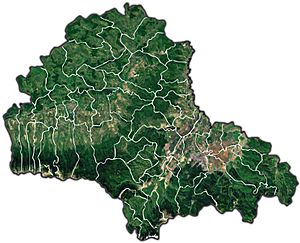
Administrative map
|
||
|
||
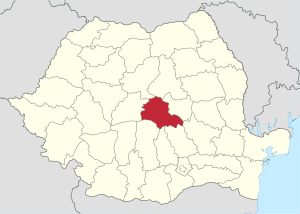
Location of Brașov County in Romania
|
||
| Country | ||
| Development region1 | Centru | |
| Historic region | Transylvania | |
| Capital city (Reședință de județ) | Brașov | |
| Government | ||
| • Type | County Council | |
| Area | ||
| • Total | 5,363 km2 (2,071 sq mi) | |
| Area rank | 25th in Romania | |
| Population
(2021-12-01)
|
||
| • Total | 546,615 | |
| • Rank | 13th in Romania | |
| • Density | 101.923/km2 (263.980/sq mi) | |
| Time zone | UTC+2 (EET) | |
| • Summer (DST) | UTC+3 (EEST) | |
| Postal Code |
50wxyz3
|
|
| Area code(s) | +40 x684 | |
| Car Plates | BV5 | |
| GDP nominal | US$ 12.960 billion (2024) | |
| GDP per capita | US$ 10,655 (2015) | |
| Website | County Council County Prefecture |
|
| 1The developing regions of Romania have no administrative role. They were formed just to attract funds from the European Union 2 as of 2007, the Prefect is not a politician, but a public functionary. He (or she) is not allowed to be a member of a political party, and is banned to have any political activity in the first six months after the resignation (or exclusion) from the public functionary corps 3w, x, y, and z are digits that indicate the city, the street, part of the street, or even the building of the address 4x is a digit indicating the operator: 2 for the former national operator, Romtelecom, and 3 for the other ground telephone networks 5used on both the plates of the vehicles that operate only in the county limits (like utility vehicles, ATVs, etc.), and the ones used outside the county |
||
Different Names for Brașov County
Brașov County is known by other names in different languages. In Hungarian, it is called Brassó megye. In German, it is known as Kreis Kronstadt.
Who Lives in Brașov County?
Knowing about the people who live in a place is called demographics. In 2021, Brașov County had about 546,615 people. This means there were about 102 people living in every square kilometer.
Most people living here are Romanians, making up about 88.33% of the population. Other groups include Hungarians (about 5.98%), Romas (about 4.98%), and Germans (about 0.40%).
Historically, Romanian people lived mostly in the west and southwest parts of the county. Hungarians lived more in the east. German communities were found in the north and around the city of Brașov.
Brașov County's Geography
Brașov County covers a total area of about 5,363 square kilometers (2,071 square miles).
The southern part of the county is home to the Carpathian Mountains. These include famous mountain ranges like the Făgăraș Mountains, Bucegi Mountains, and Piatra Craiului Mountains. In the east, you'll find the Brașov Depression, which is a lower area of land. The Olt River valley is in the west. The Perșani Mountains are located between these areas. The Olt River also flows through the northern and western parts of the county.
Two important historical regions are found here:
- The Burzenland is in the southern and central parts. It stretches from Apața in the north to Bran in the southwest and Prejmer in the east. The city of Brașov is roughly in its center.
- Țara Făgărașului is to the west. It is bordered by the Olt River to the north and the Făgăraș Mountains to the south. Its main city is Făgăraș.
Neighboring Counties
Brașov County shares borders with several other counties:
- Covasna County to the east.
- Sibiu County to the west.
- Mureș County and Harghita County to the north.
- Argeș County, Dâmbovița County, and Prahova County to the south.
- Buzău County to the southeast.
Economy and Industry
Brașov County is one of the richest areas in Romania and has a long history of industry. During World War II, fighter planes like the IAR 80 were built in Brașov. Later, during the communist era, many large factories were built. Some of these factories have adapted to modern markets, but others did not survive.
New investments, especially from foreign companies, have helped the economy recover.
The main industries in the county are:
- Making machines and cars.
- Chemical products.
- Building materials.
- Food production.
Fun Places to Visit (Tourism)
Brașov County has some of the most popular tourist spots in Romania.
Here are some of the top places to visit:
- The city of Brașov itself.
- Bran Castle, also known as Dracula's Castle.
- Poiana Brașov, a popular mountain resort.
- Predeal, another beautiful mountain resort.
- The Făgăraș Mountains, great for hiking.
- Piatra Craiului Mountains, known for their stunning views.
- The old medieval fortresses of Făgăraș and Râșnov.
- The Fortified churches in the Saxon villages of the Burzenland area.
- The Via Transilvanica, a long trail for hiking and biking that goes through the county.
How Brașov County is Governed
The Brașov County Council helps run the county. It has 34 members, called counsellors. They were chosen in the 2020 Romanian local elections.
| Party | Seats | Current County Council | ||||||||||||||||
|---|---|---|---|---|---|---|---|---|---|---|---|---|---|---|---|---|---|---|
| National Liberal Party (PNL) | 16 | |||||||||||||||||
| Save Romania Union (USR) | 8 | |||||||||||||||||
| Social Democratic Party (PSD) | 8 | |||||||||||||||||
| PRO Romania (PRO) | 2 | |||||||||||||||||
Cities and Towns
Brașov County is divided into different types of areas. It has four large cities called municipalities, six smaller towns, and 48 communes (which are like small districts with villages).

- Municipalities
- Brașov – This is the county's capital city, with about 253,200 people (as of 2011).
- Codlea
- Făgăraș
- Săcele
- Towns
- Ghimbav
- Predeal
- Râșnov
- Rupea
- Victoria
- Zărnești
- Communes
- Apața
- Augustin
- Beclean
- Bod
- Bran
- Budila
- Bunești
- Cața
- Cincu
- Comăna
- Cristian
- Crizbav
- Drăguș
- Dumbrăvița
- Feldioara
- Fundata
- Hălchiu
- Hărman
- Hârseni
- Hoghiz
- Holbav
- Homorod
- Jibert
- Lisa
- Mândra
- Măieruș
- Moieciu
- Ormeniș
- Părău
- Poiana Mărului
- Prejmer
- Racoș
- Recea
- Șercaia
- Șinca
- Șinca Nouă
- Sâmbăta de Sus
- Sânpetru
- Șoarș
- Tărlungeni
- Teliu
- Ticușu
- Ucea
- Ungra
- Vama Buzăului
- Viștea
- Voila
- Vulcan
Brașov County in the Past
|
Județul Brașov
|
||
|---|---|---|
|
County (Județ)
|
||
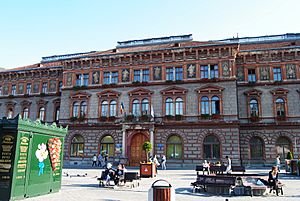
The Brașov County Prefecture building of the interwar period, currently the rectory of Transilvania University of Brașov.
|
||
|
||
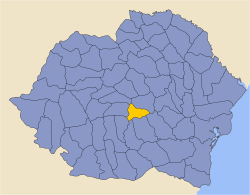 |
||
| Country | ||
| Historic region | Transylvania | |
| Capital city (Reședință de județ) | Brașov | |
| Established | 1925 | |
| Area | ||
| • Total | 2,605 km2 (1,006 sq mi) | |
| Population
(1930)
|
||
| • Total | 167,946 | |
| • Density | 64.471/km2 (166.98/sq mi) | |
| Time zone | UTC+2 (EET) | |
| • Summer (DST) | UTC+3 (EEST) | |
Historically, Brașov County was in the central part of Greater Romania. Its capital was also Brașov. The county's area grew in 1925. It covered the eastern part of today's Brașov County and the south of today's Covasna County.
It was bordered by other counties like Făgăraș and Muscel to the west. To the north was Trei Scaune County. To the east was Buzău County. To the south were Prahova and Dâmbovița counties.
History of the Old County
Before World War I, this area was part of Austria-Hungary. After the war, it became part of the Kingdom of Romania in 1920.
In 1938, the way Romania was divided changed. Brașov County became part of a larger region called Ținutul Argeș.
In 1940, some of the county's land was given back to Hungary. But in 1944, Romanian forces, with help from the Soviet Union, took it back. The county was officially dissolved in 1950 by the communist government. It was later re-established in 1968.
Old County's Population
In 1930, the old Brașov County had about 168,125 people. About half of them (49.9%) were Romanians. Hungarians made up 26.6%, and Germans were 19.8% of the population. There were also other smaller groups.
Most people (48.8%) followed the Eastern Orthodox Christian faith. Other religions included Lutheran, Roman Catholic, and Reformed.
People in the Old Cities
In 1930, the cities in the old county had about 59,232 people. In these cities, Hungarians were the largest group (39.3%). Romanians were 32.7%, and Germans were 22.0%.
The most common language spoken in the cities was Hungarian (42.2%), followed by Romanian (32.7%) and German (22.4%).
Images for kids
See also
 In Spanish: Distrito de Brașov para niños
In Spanish: Distrito de Brașov para niños


